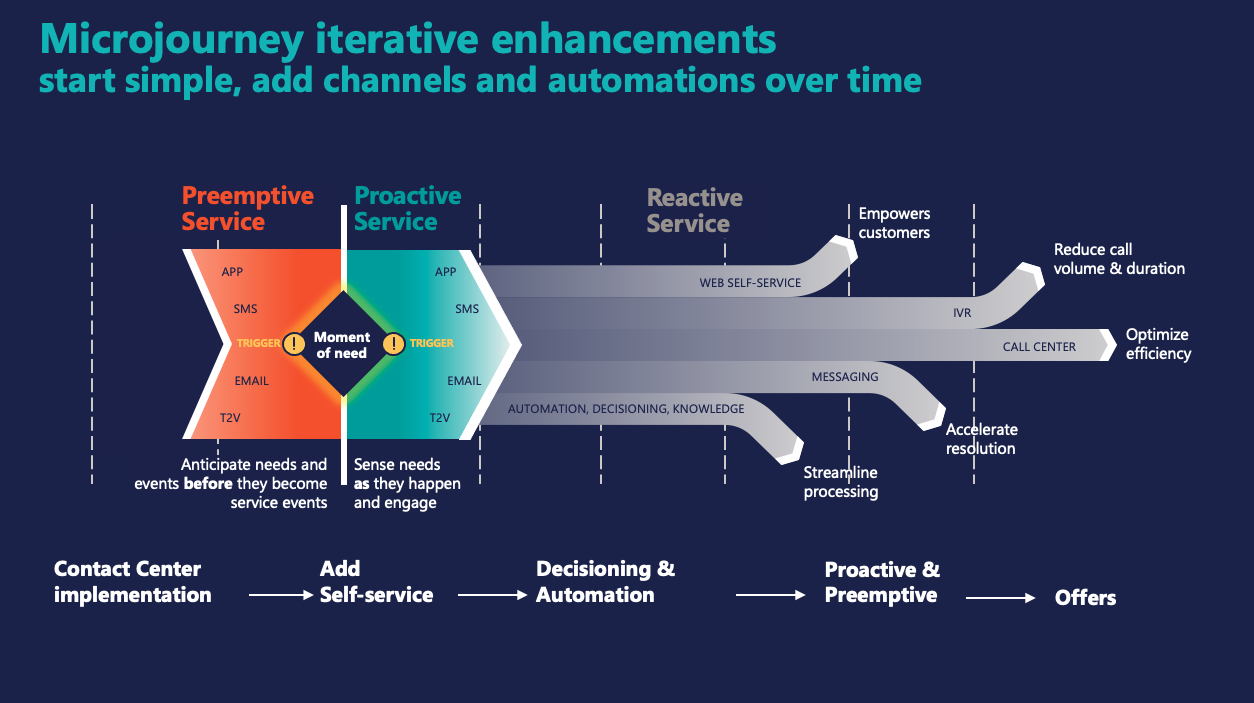If you’re using Pega for Customer Service, you probably spend a lot of time thinking about how to optimize and improve the customer journey. Modern consumers expect a lot from brand interactions and the pressure is on to deliver excellent experiences. Even if you’ve mapped everything correctly, customers may still run into speed bumps along the way. And with each servicing event acting as a potential “moment of truth” in customer satisfaction, these speed bumps can lead to crashes in customer loyalty.
So how do you begin improving these touchpoints? The answer is an iterative, Center-out approach to microjourneys.
Microjourneys are beneficial for a number of reasons. By breaking out your customer journeys into smaller units of work, the workflow and user experience can be optimized for each unit of work, making each interaction more efficient and empathetic. From the customer perspective, these small tasks – such as changing an address or reporting a lost credit card – can have a major impact.
In this article, we’re going to help you identify where to focus your microjourney efforts, show you the components of making iterative enhancements using your existing Pega toolkit, and walk you through an example of what an iterative approach to microjourneys actually looks like.
Servicing events are “Moments of Truth”
As a customer service organization, you probably have a few identifiable servicing events that serve as a “moment of truth” for customer loyalty. Get it right and the customer will stick with your brand for many years. Get it wrong and they’ll drop you as quick as they can. If you’re the customer of an insurance company, filing a claim after a car accident is one of those moments. For a bank, it may be getting a credit card replaced after it’s been lost or stolen. In these circumstances the customer is stressed-out and needs a quick and informative resolution. And while you as the company know the best solution, you’re going to need to bring together a myriad of systems, policies, decisions, and customer treatments in order to make it efficient and empathetic.
Center-out and microjourneys
Luckily, you’re not starting from scratch. Your Pega application supports these kinds of servicing events by using a Center-out approach and a rich technology ecosystem in every microjourney that ships. Let’s take look at how your existing Pega toolbox can be leveraged.
In the illustration below, you can see that the servicing event is at the core of your process, hence Center-out. On the left (Preemptive Service) is anything you can do with Pega to pre-empt the problem. While you can’t prevent car accidents, some events, like overdrafts can be predicted and prevented. Some microjourneys use modeling to send pre-emptive communications encouraging customers to make a change that will prevent negative events from occurring.

On the right (Proactive Service) of the servicing event, you can deploy strategies and actions that proactively support the process. In the insurance example of filing an accident claim, your organization can send a proactive email reminding the customer to submit the police report that often comes to them 2-4 days after the accident. Proactively getting the police report and making sure the facts therein align with what the customer says happened, is often one of steps that slows down processing. By proactively solving for this, you’re making your customers happy.
Farther to the right (Reactive Service), there are workstreams that represent channels or technologies that can be brought bear in order to increase efficiency and/or empathy. Continuing with the accident claim process, some examples are enabling the case in mobile web, so that a customer can initiate their claim and, from there, share photos and GPS location easily. Or leveraging natural language processing and decision automation to extract the contents of the police report and decide whether any related action is required.
An iterative approach
Now that you understand how to prioritize service events and what’s available in your Pega Customer Service toolkit, you can now begin configuring and deploying your microjourneys.
But what if my implementation requires high speed to value? What if there’s not enough time to fully enable the most important microjourneys?
Don’t sweat it. Start simple and add channels and automations over time.
Let’s take a look at what an iterative approach could look like using the accident claim example.
- First Release: The initial release could be nearly 100% out of the box and just have support in the contact center and web, with the automated email requesting the police report.
- Second Release: In a second release, you can enable mobile web, and using IoT integration with the insurers telemetry systems, enable an alert going to the customer allowing them to initiate their claim right from the accident site and even get roadside assistance, if needed.
- Third Release: The third release could include automating data extraction and automation of the police report sub-case.
By the end of just a few iterations, the case flow is dramatically improved. And by spreading out the workload over time, you reduce the initial effort for your team.
In conclusion, by taking an iterative, Center-out approach to microjourneys, you can increase efficiency, be empathetic to both the CSR and Customer’s needs, and create positive experiences that boost customer loyalty and retention.
Recommended Resources
- Creating a Microjourney for customer success
- Customer Service for Financial Services Microjourneys
- Pega Customer Service for Communications Microjourneys
- Customer Service for Healthcare Microjourneys
- Customer Service for Insurance Microjourneys
- Six steps to simplifying service
- 5 Trends Customer Service Leaders Can’t Ignore Post-COVID
Don't Forget
- JOIN THE CONVERSATION on Collaboration Center
- FOLLOW @PegaDeveloper on Twitter
- SUBSCRIBE to the Pega Developer Podcast on Spotify or via RSS

